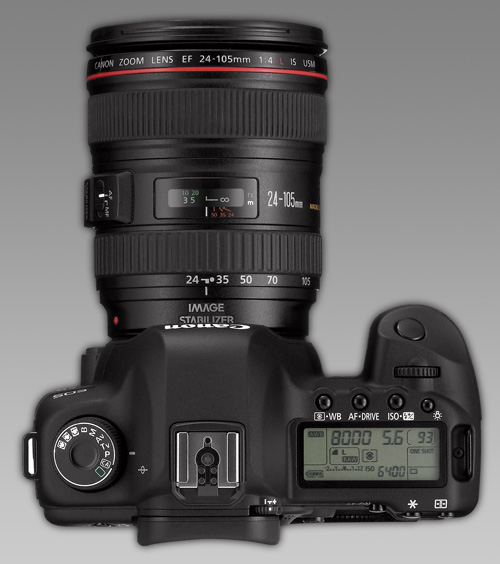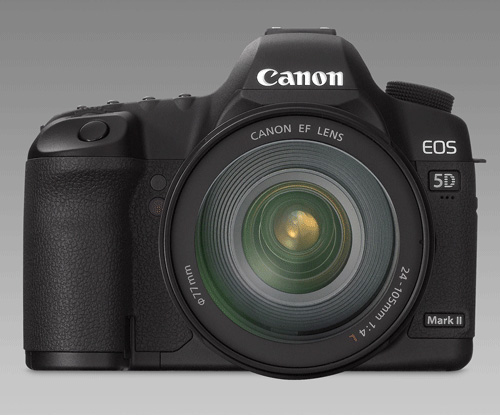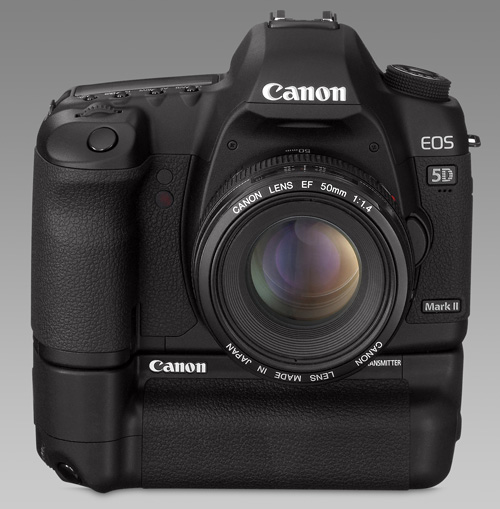Canon Announces 21.1 Megapixel 5D Mark II
by Wesley Fink on September 17, 2008 12:10 AM EST- Posted in
- Digital Camera
The Canon Europe Press Release was organized quite differently and provided more information on the 5D Mark II. It is also interesting that while the 5D Mark II is priced lower than the Sony A900 and Nikon D700 in the US, it is expected to be priced higher than these two models in Europe.
 United Kingdom/ Republic of Ireland, 17 September 2008: Canon announces the full frame, 21.1 Megapixel EOS 5D Mark II: the first EOS with full High Definition video capability. Compact, lightweight and with environmental protection, the successor to the EOS 5D boasts a newly designed Canon CMOS sensor, with ISO sensitivity up to 25,600 for shooting in low light conditions. The new DiG!C 4 processor combines with the improved CMOS sensor to deliver medium format territory image quality at 3.9 frames per second, for up to 310 frames.
United Kingdom/ Republic of Ireland, 17 September 2008: Canon announces the full frame, 21.1 Megapixel EOS 5D Mark II: the first EOS with full High Definition video capability. Compact, lightweight and with environmental protection, the successor to the EOS 5D boasts a newly designed Canon CMOS sensor, with ISO sensitivity up to 25,600 for shooting in low light conditions. The new DiG!C 4 processor combines with the improved CMOS sensor to deliver medium format territory image quality at 3.9 frames per second, for up to 310 frames.

Triggered from Live View Mode, HD video capture allows users to shoot uninterrupted at full 1080 resolution at 30fps – for amazing quality footage with outstanding levels of detail and realism.
The integration of HD movie capability into a high-end 21.1 Megapixel camera opens a multitude of new possibilities for photojournalists and news photographers. With its full frame CMOS sensor and outstanding ISO performance, the EOS 5D Mark II will appeal to any photographer in search of the finest camera equipment available – from studio and wedding to nature and travel photographers.
Enhancements from the original EOS 5D include:
- Addition of Canon’s EOS Integrated Cleaning System, with a new Fluorine coating on the low-pass filter
- Larger 3.0” Clear View LCD with VGA resolution, a 170° angle of view and anti-reflective coatings
- Improved menu system including Quick Control Screen for more direct access to common settings
- Automatic peripheral illumination correction, utilising detailed EF lens information to optimise JPEG images straight out of the camera
- Magnesium alloy construction with additional environmental protection
- UDMA memory card compatibility
“Professional photojournalists and wedding photographers already choose the EOS 5D for its discrete size and outstanding image quality,” said Mogens Jensen, head of Canon Consumer Imaging. “The addition of HD movie recording opens a new chapter for EOS. It creates new possibilities for EOS photographers to capture and share their stories and to stay relevant in a rapidly changing digital landscape.”

Key Specifications:
- New 21.1 Megapixel CMOS sensor with improved EOS Integrated Cleaning System (E.I.C.S.)
- New Full HD 1080 resolution movie recording
- 3.9 frames per second continuous shooting
- High performance DiG!C 4 processor providing superb image quality
- Maximum 310 large JPEG images in a single burst with a UDMA card
- 3.0” VGA (920k dots) Clear View LCD
- ISO 100-6400 (expansion from 50 up to 25,600)
- 9 AF points + 6 Assist AF points
Pricing & Availability:
The EOS 5D Mark II (body only) is available from end of November 2008 priced at £2299.99 / €2999.99 RRP inc. VAT.
The EOS 5D Mark II, EF 24-105mm f4.0L IS USM kit is available from end of November 2008 priced at £3049.99 / €3999.99 RRP inc. VAT.
Additional information

New CMOS sensor
The EOS 5D Mark II newly designed full frame 21.1 Megapixel CMOS sensor features ISO sensitivity from 100-6400, expandable to 50, 12,800 and 25,600. Large 6.4µm2 pixels have been redesigned to capture more light and yield a better signal to noise ratio to ensure lower noise images throughout the ISO range. The full frame sensor has the same dimensions as a frame of 35mm film. This means that wide-angle lenses stay wide, without the change in angle of view associated with smaller sensor cameras. As well as benefiting from finer control over depth of field, photographers moving up to the EOS 5D Mark II full frame format will find the newly designed wide, bright 98% coverage viewfinder a joy to work with.
New DiG!C 4 processor
A new DiG!C 4 processor combined with 14-bit analogue to digital conversion provides smooth gradations in mono-tonal areas such as skies, and highly accurate colour rendition. As well as HD movie shooting, DiG!C 4’s high speed provides for long uninterrupted continuous bursts of large JPEGs, near-instant start-up times and immediate and fast review after shooting. DiG!C 4 also provides for improved noise reduction algorithms, complementing the already low noise images from the EOS 5D Mark II CMOS sensor.
A new DiG!C 4 processor combined with 14-bit analogue to digital conversion provides smooth gradations in mono-tonal areas such as skies, and highly accurate colour rendition. As well as HD movie shooting, DiG!C 4’s high speed provides for long uninterrupted continuous bursts of large JPEGs, near-instant start-up times and immediate and fast review after shooting. DiG!C 4 also provides for improved noise reduction algorithms, complementing the already low noise images from the EOS 5D Mark II CMOS sensor.
HD video capture
The EOS 5D Mark II is Canon’s first D-SLR to incorporate full HD 1920x1080 video capture. Once filming is started from Live View mode, photographers can fire off either single or continuous stills, with video capture continuing after the final frame is captured.
The EOS 5D Mark II is Canon’s first D-SLR to incorporate full HD 1920x1080 video capture. Once filming is started from Live View mode, photographers can fire off either single or continuous stills, with video capture continuing after the final frame is captured.
See everything
A new 3.0” VGA resolution LCD provides a wide 170º angle-of-view, providing plenty of clarity for accurate focus checks in playback. The screen brightness can automatically adjust to suit viewing conditions, extending battery life in low light and improving viewing in bright conditions. A new dedicated Live View button switches modes to display a real-time image on the LCD. This allows EOS 5D Mark II photographers to enjoy simplified shooting from awkward angles. Simple connection to a PC provides easy remote shooting.
A new 3.0” VGA resolution LCD provides a wide 170º angle-of-view, providing plenty of clarity for accurate focus checks in playback. The screen brightness can automatically adjust to suit viewing conditions, extending battery life in low light and improving viewing in bright conditions. A new dedicated Live View button switches modes to display a real-time image on the LCD. This allows EOS 5D Mark II photographers to enjoy simplified shooting from awkward angles. Simple connection to a PC provides easy remote shooting.
Precision focus and metering
A 9-point auto focus system is supported by 6 additional invisible Assist AF points, located inside the spot-metering circle to optimise subject tracking performance in AI SERVO AF mode. For accurate exposure readings in tricky lighting conditions, the spot metering circle covers just 3.5% of the frame.
A 9-point auto focus system is supported by 6 additional invisible Assist AF points, located inside the spot-metering circle to optimise subject tracking performance in AI SERVO AF mode. For accurate exposure readings in tricky lighting conditions, the spot metering circle covers just 3.5% of the frame.
Control
The EOS 5D Mark II redesigned menu system includes a new Quick Control screen, for instant access to the most commonly changed settings. A new Creative Auto mode allows photographers to cede control of key settings to the camera, while retaining control over creative variables such background blur, drive mode and image brightness. Custom user settings allow photographers to switch between two completely different camera setups. This is ideal for changing quickly between two different environments, such as switching from working inside a church without flash to outdoors with fill-flash at a wedding.
The EOS 5D Mark II redesigned menu system includes a new Quick Control screen, for instant access to the most commonly changed settings. A new Creative Auto mode allows photographers to cede control of key settings to the camera, while retaining control over creative variables such background blur, drive mode and image brightness. Custom user settings allow photographers to switch between two completely different camera setups. This is ideal for changing quickly between two different environments, such as switching from working inside a church without flash to outdoors with fill-flash at a wedding.

Accessories
Shooting flexibility is enhanced with a range of new accessories. Shooting capacity can be extended with either the high capacity 1800mAh lithium-ion Battery Pack LP-E6, or Battery Grip BG-E6. A new optional Wireless File Transmitter – the K271 – offers external HDD and GPS compatibility along with the ability to transmit images direct to computer or FTP server, or operate the camera wirelessly. Both the BG-E6 and K271 feature a vertical orientation shutter release and other key controls for comfortable portraiture work, with a substantial grip to help balance the camera when used with long lenses.










38 Comments
View All Comments
melgross - Wednesday, September 17, 2008 - link
I wasn't shocked. They have always had a decent range of lenses, though not nearly as extensive as from Canon and Nikon. But you have to know that most of those lenses were designed as long as 15 years ago (a couple are even older!). The last ones were designed before Sony bought the Konica-Minolta brand.None of those lenses were designed for digital, and it shows.
There has been a lot of criticism in the industry about Sony ignoring those older lenses. They simply are not up to modern professional standards, though most are good enough for other work.
The Zeiss lenses are fine lenses, they can compete anywhere in optical and mechanical quality, except for the odd fact that they are not environmentally sealed.
Heidfirst - Wednesday, September 17, 2008 - link
" I think everyone at the event was shocked at the huge number and range of the current Sony Lens selection. I know I was. "Sony have promised to have a minimum 40 lens lineup - this may not seem a lot compared to Canon or Nikon but then think that they don't need IS & non-IS versions so their 40 is Canon or Nikon's 80.
At the wide end Sony can already pretty much compete with Canon & Nikon bar a few specials like T&S/PC (of course they also have a few unique lenses themselves) but they are still lacking a bit at the extreme tele end. I'm sure that they know this though & at least 1 of the prototypes that they have been showing appears to be an extreme tele (400mm f2.8 ?).
Wesley Fink - Wednesday, September 17, 2008 - link
You need to visit some Canon 5D Forums to get cheered up. Most in those Forums are complaining about the slow burst speed compared to Nikon and the "archaic AF mode" compared to the Nikon D700. Your opinion of the new 5D Mark II all depends on what features matter most to you.n4bby - Wednesday, September 17, 2008 - link
agreed. i don't think the D700 is disappointing at all. if you've used a D3, you know how amazingly capable that sensor is... the sensitivity is unbelievable. i'm skeptical the 5D II will be as clean at ISO6400+, but then it has a lot more pixels to work with so by the time you scale it down to 12MP it might similar. hopefully the dynamic range is on par with or better than the D3/D700 as well.even as a Canon user who has been waiting for this model for 2 years, i'm not sold until i can see some exhaustive image quality tests, as well as use it in my own hands. the video is neat but in the end this is a camera for capturing still images, and the real measure is how well it does that. in that respect, the D700 is still an excellent camera, regardless of what the 5D II is capable of.
n4bby - Wednesday, September 17, 2008 - link
> i am a nikonian and very disappoint in nikon. the d700 sux compare to what's coming ahead.ha! nikon users are in heaven right now compared to a few years ago. did you forget what it was like to be a d1x user for 4 years, waiting for a new model while canon had upgrade after upgrade every year? :)
dash2k8 - Wednesday, September 17, 2008 - link
I agree that a 1Ds Mark III replacement sounds very likely. Otherwise why would Canon scuttle its own flagship body with a nearly-identical product? Canon really timed this nicely and has effectively stolen all the thunder the Sony a900 caused recently. I know that I am going to buy a 5D Mark II without hesitation.melgross - Wednesday, September 17, 2008 - link
Early next year.araczynski - Wednesday, September 17, 2008 - link
i don't know jack about the dslr market, but that just felt like someone kicking sony (their alpha900 announcement) in the gut.sounds like a great camera.
ncage - Wednesday, September 17, 2008 - link
I doubt it. Sony is a very small player in the DSLR market and i don't expect that to change anytime soon. They are doing this to compete with the D3/D700 from nikon. Nikon was beating them since their release. Don't expect this canon to trounce on the nikon just because of the mp increase. The nikon 12-13MP is sufficient for most people and actually a lot of people don't want higher MP because of the noise associated with it. The nikon have VERY good low noise / high ISO abilities which is what most photographers want.Now your probably asking why is sony such a small player. Well i think of it has to due to lenses. Yes sony bought the minolta line of lenses way back when but they are not nearly as nice as the professional nikon/canon glass and when you spend this much on a camera then its all about glass. Sony always seems to have "something missing" in their bodies too. Nikon/Canon have been doing this for so long they know what professionals need/want.
I want to see if there is any dramatic price drop in the D700 after this camera starts selling. If it drops to $2k then i'm definetly going to pick one up. Its the camera body ive been lusting after and since all my glass is the F-Mount nikon stuff and since i'm not going to go through the MAJOR expense of switching all my glass otherwise id probably give the 5D MKII a look.
takumsawsherman - Friday, September 19, 2008 - link
Part of this is in response to your assertion about lenses, but part is in response to the general negativity surrounding the Minolta (oops! Sony) release.Having had my first Minolta a long while back (a Maxxum 7000 film camera), I was always impressed with their products, and very much so with their lenses. I've had different models over the years (my 7000's were stolen) and now primarily shoot with an Alpha 707. The Sony represents a nice way for me to upgrade without losing my current lenses. I've not seen it, nor have I tried it, as I still have an attachment to film, and want to be the last hold out :). But it looks like Sony has an excellent Minolta product with the A900.
As in the past, however, Nikon and Canon have a sort of "anointed" state of grace amongst some. I can't think of any "glass" that Minolta couldn't compete with in the film days, and the quality of the cameras and the pictures they take is phenomenal. Yes, I lusted for an F5 at one point, but also for a Maxxum 9 (I still want one of those, in fact).
Sony is a small player because Minolta was always a small player, despite often having better features and specs than competing cameras. Sony also has earned a bad rep for some of the less customer-friendly aspects of the company.
In short, I look forward to all improvements in the digital camera realm, especially with sensor sizes, as I still don't see a compelling reason to switch from film, other than the convenience factor. I have sometimes spent upwards of $800/year in film processing/prints, etc, but I would be spending much more than that on the Sony body just to have to still incur the costs of making prints. Meanwhile, the quality of Fuji Pro400N (used to be 400NPH) seems as good or better than the quality of the best 35mm digital I have seen. Don't even get me started on Black and white (where I still think that Ilford rules the roost).